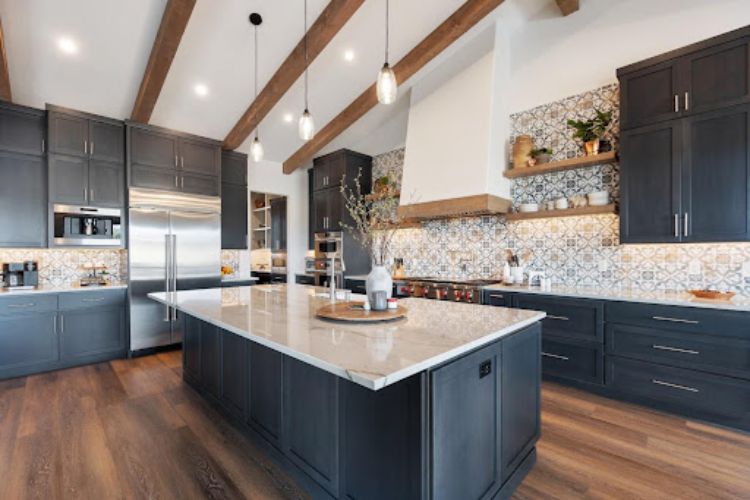The kitchen is the heart of every home. It’s where design meets daily life. The floor you choose affects how the space looks, feels, and lasts. Hard flooring remains a favorite because it’s beautiful, durable, and easy to maintain. This guide explores the most popular options that combine style with lasting value.
Hardwood Flooring: Timeless Beauty That Adds Warmth
Among all hard flooring choices, few materials match the natural beauty of hardwood. It brings warmth and elegance that never go out of style.
Oak Flooring and Its Classic Appeal
Oak has been a kitchen favorite for decades. Both red oak and white oak offer unique charm. Red oak has a rosy tone and bold grain pattern, while white oak looks smoother and more modern. Each one blends easily with any kitchen design.
Oak resists stains and scratches when sealed properly and can be refinished several times, giving it both impressive longevity and strong resale appeal. Its strength and versatility make it a dependable choice for homeowners seeking a balance between tradition and durability.
Still, choosing the right type of hardwood and finish can feel overwhelming, especially with so many options available today. Visiting reliable flooring specialists like Carpet Call can help homeowners compare materials, colors, and textures before committing to a final design.
Engineered Hardwood vs. Solid Hardwood
Solid hardwood is made from a single piece of wood. Engineered hardwood combines a real wood surface with layers of plywood underneath. This layered design helps it handle humidity better than solid planks. It’s ideal for kitchens, where spills and moisture are common.
Engineered flooring is often installed as a floating floor, which makes the process faster and easier. Both types offer warmth, natural grain patterns, and long-term value when properly maintained.
Exotic Hardwood Options for a Luxurious Look
If you want something distinctive, exotic hardwoods like teak, mahogany, and Brazilian cherry make a statement. They have rich colors and tight grains that stand out in any design. These woods are very dense, so they resist dents and scratches well.
However, exotic hardwoods can be expensive. It’s also best to look for certified sustainable products to ensure they’re responsibly sourced.
Tile Flooring: Durable and Stylish for Busy Kitchens
Tile flooring is a practical choice for homes that see a lot of cooking and foot traffic. It offers endless design options and excellent strength.
Ceramic vs. Porcelain Tile
Ceramic and porcelain tiles look similar but perform differently. Porcelain is fired at higher temperatures, making it denser and less porous. That means it handles moisture better and works perfectly for kitchen floors.
Ceramic tile, on the other hand, is easier to cut and usually costs less. Both types come in many colors and textures, allowing you to create anything from a sleek modern look to a rustic farmhouse feel.
Natural Stone for a Premium Finish
Natural stone such as granite, marble, slate, and travertine adds depth and texture to a kitchen. Each stone has its own character, so no two floors look alike. Stone does need sealing to prevent stains, but its natural variation and premium finish make it stand out. Although installation costs more than other options, stone tile’s long life and timeless appeal often justify the price.
Modern Alternatives: Laminate and Vinyl Flooring
Thanks to new manufacturing techniques, laminate and vinyl flooring now look remarkably similar to natural wood or stone. They’re affordable, low-maintenance, and great for busy kitchens.
Laminate Flooring for an Authentic Wood Effect
Laminate flooring uses several layers: a stable core, a printed design, and a strong wear layer that protects against scratches. It installs easily as a floating floor and is simple to clean.
One limitation is moisture. Traditional laminate can swell if water seeps through the seams. Some newer versions include water-resistant coatings, which make them safer for kitchens and dining areas.
Vinyl Flooring and Vinyl Plank for Everyday Durability
Vinyl flooring, especially luxury vinyl plank (LVP), has become one of the most popular modern choices. It’s completely waterproof and comfortable underfoot. LVP can replicate natural wood or stone so well that many people can’t tell the difference.
Vinyl flooring also transitions nicely into open spaces like the living room, keeping the home’s design consistent. It’s affordable, easy to repair, and long-lasting. With proper care, vinyl can look great for up to 15 years.
Choosing the Right Hard Flooring for Your Kitchen
The best flooring depends on your lifestyle, budget, and design goals. Taking time to compare your options ensures the kitchen will look good and function well for years.
Consider Key Factors Before Deciding
When comparing materials, focus on what matters most:
- Moisture resistance: Porcelain tile and vinyl plank handle spills best.
- Ease of maintenance: Laminate and engineered hardwood need little upkeep.
- Budget: Vinyl and laminate deliver strong visuals at lower costs.
- Longevity and resale value: Hardwood and natural stone offer the best returns.
Weighing these points helps you find a balance between beauty, practicality, and long-term performance.
Matching Flooring With the Rest of Your Home
A kitchen floor should feel connected to the rest of your house. Choose materials and colors that complement nearby rooms, especially open-plan layouts. For example, pairing white oak floors in the kitchen with light-toned vinyl planks in the living room creates harmony and visual flow without overspending.
Final Thoughts
Each hard flooring option has its strengths. Hardwood adds warmth and character. Tile brings durability and easy cleaning. Vinyl and laminate provide modern style at an affordable price. The right choice depends on your needs, lifestyle, and design taste. When selected thoughtfully, flooring doesn’t just cover the kitchen; it defines it.

